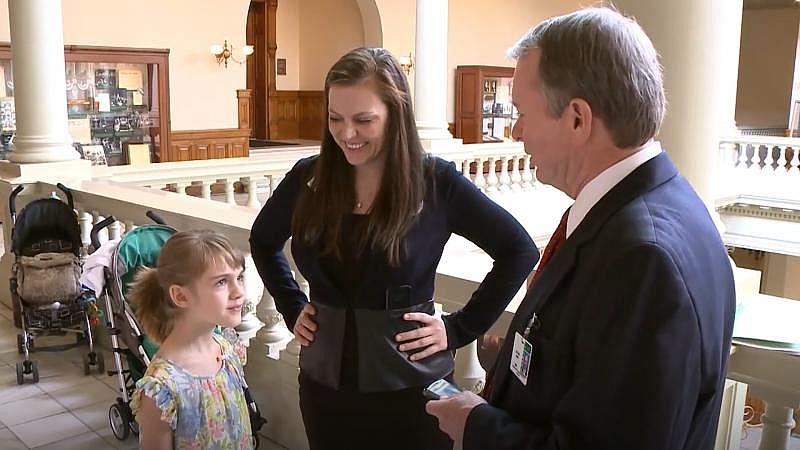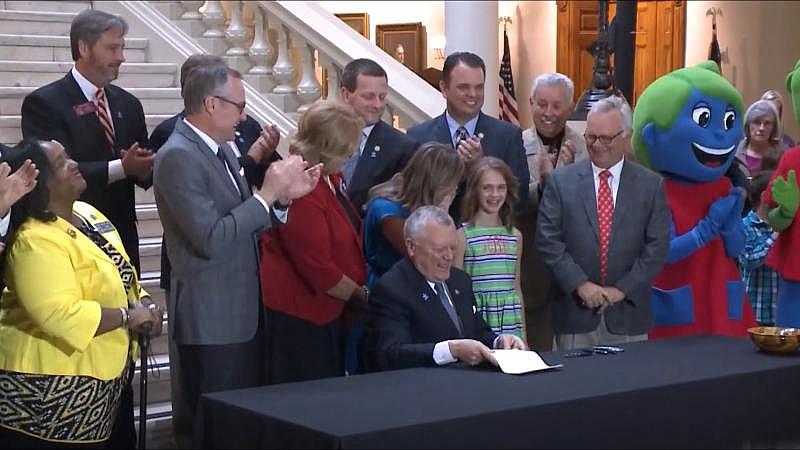Her first word: Cheeto. Once a non-verbal toddler with autism, Ava hopes her story will help other children with special needs
This story was produced as part of a project for the 2020 Data Fellowship, a program of the USC Annenberg Center for Health Journalism.
Other stories by Rebecca Lindstrom include:
Sexual exploitation, just one more danger to a mental health crisis
Broken furniture, broken hopes: Georgia mom stuck in loop trying to get help for son with autism
Teen finds team to score touchdown in life: How new DFCS program could prevent child abandonment
Homeless. Jail. Sexually exploited. The Game of Life never talked about this.
'I don't want to hurt nobody' | Woman with autism confronted by police
Georgia lawmakers commit to tackling child abandonment in next legislative session
Mom says she left note with abandoned child, police never found it
Georgia Families Struggling With Access To Mental Healthcare Will Soon See Changes

11Alive
FIGHTING FOR ACCESS
Ava Bullard is no stranger to Georgia’s Capitol. For seven years, Ava and her mother Anna showed up to testify before legislative committees and lobby in the halls. She is the namesake of Ava’s Law which passed in 2015, mandating insurance provide coverage to children for treatments associated with autism.
“It’s just weird being here when it’s empty,” Ava said as she walked the halls again. Six years have passed. She’s no longer a little girl. She’s a senior preparing to head off to college. Her mother stands beside her, beaming with pride.
Her mom remembers when Ava was diagnosed as a toddler with autism.
“She was non-verbal, she had no skills when she was 2.5 years old. No feeding skills, play skills. The shocking part was none of the services that were prescribed by the physician were covered by insurance or Medicaid,” her mother said.
But Ava’s parents knew intervention at a young age could make a difference. So they maxed out their credit cards. Their families chipped in too. After a few weeks of Applied Behavioral Analysis, ABA, the progress was obvious. Ava spoke her first word.
“I think it was Cheeto. Her therapist said, we have to find things that she likes,” Anna recalled. For the record, Ava still likes Cheetos.
Her family could have moved to a state where ABA therapies were covered by insurance, but Anna said it just didn’t feel right.
“How can I leave this state that I love, my family has been here forever. And how can I just leave knowing all these children won’t receive services? That’s when I decided we’re going to stay, we’re going to get Ava therapy and we’re going to get everyone else therapy because this is wrong,” she said.
ABA trained therapist Lindsie Jones is not surprised by Ava’s story. She says the therapy method is an important tool to help children and their parents find healthy ways to communicate before frustration turns to aggression.
“We’re basically figuring out the function. Why is this person doing the behavior that they’re doing,” Jones explained, who works with youth at Creative Community Services. “Sometimes youth get too big and their aggression becomes dangerous. I think that’s when the parents feel overwhelmed and they just can’t handle it.”
But children with ADHD and PTSD, the primary diagnosis of children who are abandoned, don’t generally qualify for coverage. Ava’s Law only relates to children with autism.
“ABA can help anybody,” Jones said, acknowledging the risk of abandonment for some of these children is real. She says if therapies like ABA can be used early on with children, not just those with autism, some families would likely stay together.
“That preventative aspect, I hope that one day we can get on that side of the fence and help before the parent has to make that decision,” she said.
INSURANCE COVERAGE ISN'T ENOUGH
Even if Georgia expanded services, giving someone access isn’t enough. There have to be therapists to provide the service. That’s why when Ava’s Law did pass, Georgia set a high Medicaid reimbursement rate compared to other states.
“So that has brought a lot of providers here to Georgia,” Anna Bullard said.
It’s proof that if you properly fund a program, providers able to deliver it will come. Child welfare advocates say it's time to take the same approach to other parts of our behavioral health care system. And we can’t wait seven years to do it.
“If we don’t address the parity issue then we’re going to continue to struggle,” Gwen Skinner said, the vice president of operations for Devereux, a psychiatric residential treatment facility in metro Atlanta.
“Devereux serves children with significant emotional disturbance,” Skinner said.
It is one of the few facilities in Georgia that will work with children struggling with aggressive behaviors, another gap in our behavioral health care system. Skinner knows about the gaps first hand, as well as through her work as Chair of Georgia’s Workforce and System Development Committee on the Behavioral Health Reform and Innovation Commission, BHRIC.
“It’s not that it’s a challenging population to work with, it’s can you recruit and retain the professionals to be able to do that,” Skinner explained. “It’s a specialized service so you have to accept that it’s going to cost more to provide a specialized treatment track.”
It may cost more, but she says the state doesn’t pay more forcing Devereux and others to take patients from states that do reimburse at higher rates. For example, she says, Georgia pays about $2850 for a youth to receive a week of treatment at Devereux. Florida will pay $4200.
“We’re losing capacity in Georgia. The providers are beginning to take more and more out-of-state youth in order to remain financially viable. So that means Georgia youth when they have those needs, there’s nowhere to go,” Skinner said.
Gaps in access lead to gaps in the workforce. Take child psychologists for example. It’s a specialized field, so it takes more years of training than a pediatrician. That means more debt. Yet a 2019 Milliman Research Report found insurance in Georgia pays 38-percent less for behavioral health care than medical.
“It is expensive to become a psychiatrist. But if you choose that professionally, you know you are going to make less than if you chose a traditional medical physician role. So we know there’s got to be parity in what the professionals make,” Skinner explained.
The real-world impact of that pay disparity, according to a survey by VOICES for Georgia’s Children, is a shortage of mental health professionals in 150 of our 159 counties. Seventy-six of those counties don’t have a single full-time psychiatrist or psychologist. Access is further eroded when according to research by BHRIC, only 53 percent of psychiatrists in Georgia even accept Medicaid.
The problems with our workforce extend beyond positions that require advanced college degrees. Many families say what they need are simply in-home supports, trained staff that can help with routine care. Getting an authorization for that is tough, getting people to do the job may be tougher considering it often pays just ten dollars an hour.
“We know that you can’t live off ten dollars an hour. And this is really, really hard work,” Eric Jacobson said the Executive Director of the Georgia Council on Developmental Disabilities. “When we talk about nursing homes getting increased rates or hospitals getting increased rates from the state, they never have included providers of developmental disability services or other home and community-based services in that conversation.”
Since most of the children that would qualify for those services are on Medicaid, reimbursement rates for those types of services would also be set by the Department of Community Health and the legislature.
That’s why Skinner jumped at the opportunity to serve on BHRIC.
“My first thought was, I want to be a part of that. My second thought was, I hope it’s not going to be just another commission that makes recommendations and doesn’t result in sustainable change for our state. Because that’s where we must go,” Skinner recalls.
When asked if that sustainable change has happened yet, she quickly replied, “No.”
But Skinner does believe the 2022 legislative session will bring change. She says Georgia needs a state care plan that provides a road map for care, regardless of who is Governor or leading the departments involved.
CHANGE IS POSSIBLE
Anna and Ava warn families to get ready for a fight over money.
“I’ll never forget one of the legislators... looked at me and he said, it’s not personal. And I thought it’s very personal! It’s very, very personal,” Anna Bullard recalls.
According to Georgia’s insurance commission, Ava’s Law has increased monthly insurance premiums by 97 cents. But Ava says look at what that dollar has done for her.
“I wouldn’t be where I am today, at all,” Ava said.
From a toddler that couldn’t talk to a senior at Toombstone High School. Ava is a cheerleader at the top of her class as a dual enrollment student at Georgia Southern.
“The answer can’t be how to do we just keep throwing money and getting more providers. The answer has to be how do we focus on ensuring that what that child is getting is what the science says they should get. What outcomes should they expect?” Anna said. She believes if we follow that science, we will see those service gaps and places where providers and insurance companies aren’t being held accountable.
That’s now the focus of Anna Bullard’s new fight. She’s taken a job with the Behavioral Health Center of Excellence, lobbying across the country this time to make sure programs that do exist are using proven methods to get quality results.
The Bullards hope their story offers some hope that change can happen – if you’re willing to fight.
POSSIBLE SOLUTIONS
During this investigative series, we are asking those in the middle of it, "what is a solution." Here's what they say.
- Increase reimbursement rates for therapists that work non-traditional hours, with kids that have aggressive behaviors, or in-person with children in rural areas.
- Increase the reimbursement rate for in-home supports and provide greater access when medically necessary.
- Expand coverage and access to ABA therapies to children who could benefit, not just those diagnosed with autism.
- Create a loan repayment program for behavioral health clinicians that agree to work in underserved communities.
- Establish parity in reimbursements for mental health care as medical care.
Ava's fight for mental health reform





Credit: WXIA
This story was told as part of a 2020 Data Fellowship with the USC Annenberg Center for Health Journalism.
The Reveal is an investigative show exposing inequality, injustice, and ineptitude created by people in power throughout Georgia and across the country.
[This article was originally published by 11Alive]

